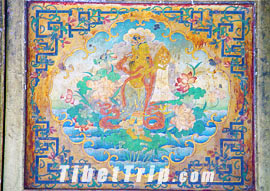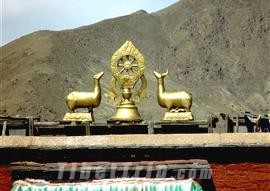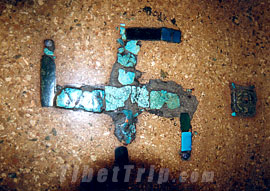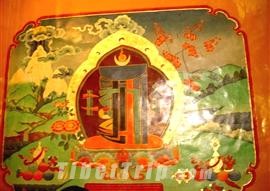Religious symbols are a common kind of adornment in the temples or houses of the religious Tibet. They are closely connected with Tibetan Buddhism and considered as sacred and propitious articles for the Tibetan.


Eight Mascots of Tibet
These are the most popular group of pictures in the traditional paintings. Most of them appear not only in the murals or in sculptures and are reproduced as artworks now. There are eight motifs, all of which are part of Buddha and meaningful in Tibetan Buddhism.

White Conch: It is recorded in the sutras that the prayer sound of
Sakyamuni is as loud as that of the conch. So conch symbolizes the words of Buddha and the everlasting echoes of dharma. They are often used as instruments to be played in the religious ceremonies with the dextral white conch being the most respected in Tibet.

Vase: Often filled with clean water (amrita) and gems in the temple, it can be found with a peacock plume or a lucky tree stuck in it. This symbolizes good omen, cleanliness, good fortune and the perpetuation of souls. This is considered the throat of Buddha.


Golden Wheel: Or Dharma Wheel: represents the unceasing spread of dharma and the feet of Buddha. They are often matched with a male and a female kylin which will arouse the kindness of mankind to carry out religious duties.

Umbrella: The former sun-proof article for the imperial and aristocratic family is used in Tibetan Buddhism and symbolizes the authority of the teachings of Buddha. It also represents the head of Buddha here.

Propitious Knot: Originally considered a symbol of eternal love and devotion, it now represents the will of Buddha, which can lead mankind to harvest wisdom and be awakened.

Golden Fish: Often appears in pairs and points to the mukti (deliverance) in Tibetan Buddhism. As their eyes could penetrate the dirty water, they also represent the clear-sighted eyes of Buddha.


Lotus: It lives in the silt but is not stained and so it represents the goal of Tibetan Buddhism and the tongue of Buddha.

Victory Standard: Symbolizes the victory of Buddhism over worries and also the body of Buddha.

Buddhist Swastika
The propitious symbol appears in front of almost all the breasts of the images of Buddhas and Bodhisattvas in temples. It stands for sobriety, kindness, wisdom and merit. The infinite extension of the character also symbolizes the immense power of Buddha in the salvation of all mankind. It follows clockwise in Buddhism while anticlockwise in
Bon.


Kalacakra Seal
The group of pictures consist of seven Sanskrit characters and three graphics of sun, moon and a circle. The five colors in the picture represent water, fire, wind, earth and sky of the Universe. The whole picture is believed to be very powerful and have mystic meaning related to Buddhism, also appearing on the obverse of the body of the
stupa.
In additional, some good omen animals, like lions, kylins, elephants, horses, tigers, peacocks and others are often used in the decoration of furniture, sculptures and paintings to pass on some good wishes. For example, the enshrined seat of the statues of Buddha is decorated with six of these animals - lion, elephant, horse, peacock, Jivajivaka (Co-fate Bird, a legendary animal with the head of human and body of bird in Buddhism) and Bodhisattva of Strength Vajradhara.END=OM MANI PADME HUM.( 3 TIMES ).RESEARCH BUDDHIST TIBET DHARMA BY BIKKHUNI GESHE TESERING TASHI.AUSTRALIA.5/2/2012.OM MANI PADME HUM.




No comments:
Post a Comment